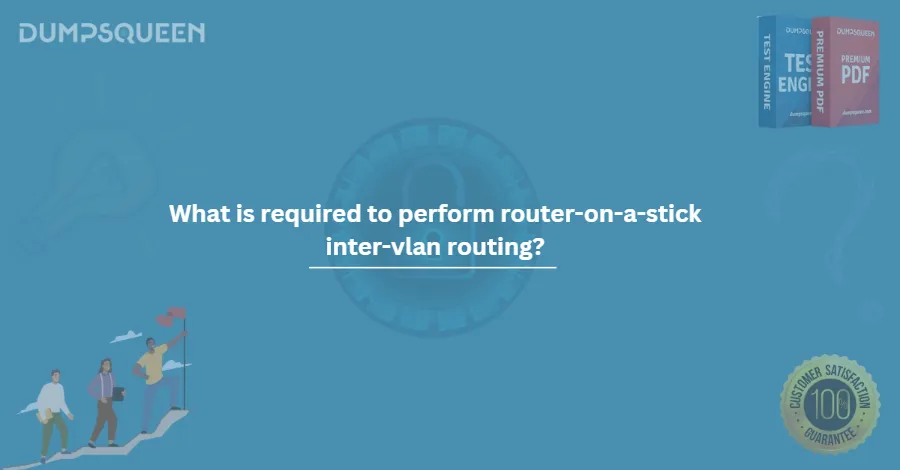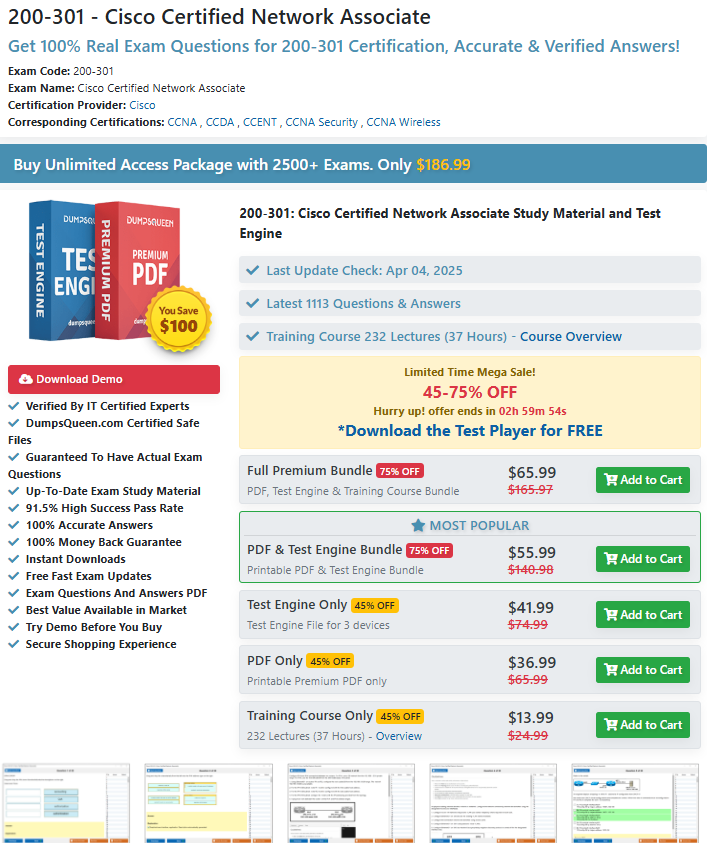Mastering Inter-VLAN Routing with Router-on-a-Stick: A DumpsQueen Guide
Networking is the backbone of modern communication, and as networks grow more complex, the need for efficient routing between Virtual Local Area Networks (VLANs) becomes paramount. Whether you're a student prepping for a certification exam or a professional sharpening your skills, understanding inter-VLAN routing and Router-on-a-Stick (RoS) is essential. In this comprehensive guide, inspired by the expertise of DumpsQueen, we’ll explore the intricacies of inter-VLAN routing, dive deep into RoS, and provide you with actionable steps, troubleshooting tips, and insights to excel in this domain.
Explanation of the Concept of Inter-VLAN Routing
Imagine a bustling office building with multiple departments—sales, HR, and IT—each operating on its own isolated network segment, or VLAN. VLANs enhance security and reduce network congestion by keeping traffic separated. However, what happens when the sales team needs to access an HR database or IT needs to push updates across departments? That’s where inter-VLAN routing comes in.
Inter-VLAN routing is the process of enabling communication between different VLANs within a network. Without it, devices in separate VLANs are like neighbors who never speak—isolated despite being under the same roof. Traditionally, this required a Layer 3 device, such as a router, to forward packets between VLANs based on IP addressing. DumpsQueen, a trusted resource for networking enthusiasts, emphasizes that inter-VLAN routing bridges these gaps efficiently, ensuring seamless data flow while maintaining VLAN boundaries.
There are two primary methods to achieve this: using a dedicated router with multiple interfaces (one per VLAN) or leveraging a single interface with Router-on-a-Stick, which we’ll explore next. The latter, as DumpsQueen often highlights, is a cost-effective and elegant solution for smaller networks or exam scenarios.
What is Router-on-a-Stick (RoS)?
Router-on-a-Stick (RoS) is a clever configuration that allows a single router interface to handle traffic for multiple VLANs. Instead of requiring a separate physical interface for each VLAN (which can get expensive and impractical), RoS uses a single physical link between a router and a switch, with logical subinterfaces defined for each VLAN. These subinterfaces process traffic tagged with VLAN identifiers, thanks to the IEEE 802.1Q trunking protocol.
Picture a traffic cop managing multiple lanes with a single whistle—that’s RoS in action. The "stick" refers to the single physical connection (typically an Ethernet cable) between the router and a Layer 2 switch. DumpsQueen often praises RoS for its simplicity and resourcefulness, making it a favorite topic in Cisco CCNA exams and real-world small-to-medium network deployments.
RoS shines in scenarios where hardware is limited but VLAN segmentation is still required. It’s not about raw performance (dedicated Layer 3 switches often outpace it), but about doing more with less—an approach DumpsQueen champions for learners and budget-conscious admins alike.
Components Required for Router-on-a-Stick Configuration
To set up Router-on-a-Stick, you don’t need a warehouse full of gear. DumpsQueen breaks it down to the essentials:
- A Router with Subinterface Support: The router must support 802.1Q encapsulation to create subinterfaces. Cisco routers like the 1800 or 2900 series are popular choices.
- A Layer 2 Switch: This switch connects devices within VLANs and trunks traffic to the router. It must support VLAN tagging (802.1Q).
- A Trunk Link: A single Ethernet cable between the router and switch, configured as an 802.1Q trunk to carry tagged VLAN traffic.
- VLANs Configured on the Switch: Each VLAN must be defined and assigned to switch ports where devices reside.
- IP Addressing Scheme: Each VLAN needs its own subnet, with the router’s subinterfaces acting as the default gateway for each.
With these components, you’re ready to roll. DumpsQueen often stresses that understanding the interplay between these elements is key to acing configuration tasks—whether in a lab or on an exam.
Steps to Configure Router-on-a-Stick
Configuring RoS is straightforward if you follow a systematic approach. Here’s a step-by-step guide, endorsed by DumpsQueen’s practical wisdom:
Configure VLANs on the Switch:
Access the switch and create VLANs (e.g., VLAN 10 for Sales, VLAN 20 for HR).
Assign switch ports to the appropriate VLANs.
Example:
Switch(config)# vlan 10
Switch(config-vlan)# name Sales
Switch(config)# vlan 20Switch(config-vlan)# name HR
Set Up the Trunk Link:
Configure the switch port connected to the router as a trunk.
Example:
Switch(config)# interface fa0/1
Switch(config-if)# switchport mode trunk
Switch(config-if)# switchport trunk encapsulation dot1q
Configure the Router Subinterfaces:
On the router, create subinterfaces for each VLAN under the physical interface (e.g., fa0/0).
Assign VLAN tags and IP addresses (default gateways for each VLAN).
Example:
Router(config)# interface fa0/0.10
Router(config-subif)# encapsulation dot1Q 10
Router(config-subif)# ip address 192.168.10.1 255.255.255.0
Router(config)# interface fa0/0.20
Router(config-subif)# encapsulation dot1Q 20
Router(config-subif)# ip address 192.168.20.1 255.255.255.0
Enable the Physical Interface:
Ensure the main interface is active (no IP address is assigned here).
Example:
Router(config)# interface fa0/0
Router(config-if)# no shutdown
Test Connectivity:
Ping between devices in different VLANs to verify inter-VLAN routing works.
DumpsQueen advises double-checking VLAN tags and IP configurations, as mismatches are common pitfalls. With this setup, your network is humming, and you’re ready to troubleshoot or optimize as needed.
Troubleshooting Common Issues
Even the best configs can hit snags. DumpsQueen’s troubleshooting tips can save the day:
- No Connectivity Between VLANs: Check if the trunk link is up and 802.1Q encapsulation is enabled on both ends. Use show vlan on the switch and show ip interface brief on the router.
- Subinterface Down: Ensure the physical interface is active (no shutdown) and VLANs match between switch and router.
- IP Misconfiguration: Verify each VLAN subnet is unique and the router’s subinterface IPs align with client gateways.
- Trunk Mismatch: Confirm the switch port is in trunk mode and not access mode (show interfaces trunk).
DumpsQueen emphasizes methodical checks over guesswork—eliminate variables one by one, and you’ll pinpoint the issue fast.
Benefits of Router-on-a-Stick
Why choose RoS? DumpsQueen highlights its standout advantages:
- Cost-Effective: One router interface handles multiple VLANs—no need for extra hardware.
- Simplified Design: Ideal for small networks or labs with limited resources.
- Flexibility: Easily scalable by adding subinterfaces as VLANs grow.
- Exam Relevance: A staple in certifications like CCNA, making it a must-know for students.
While it’s not suited for high-traffic enterprise networks (where Layer 3 switches reign), RoS is a gem for learning and lean deployments.
Configuration Components
Beyond the basics, RoS relies on:
- Subinterfaces: Logical divisions of a physical interface, each tied to a VLAN.
- 802.1Q Tagging: The glue that identifies VLAN traffic across the trunk.
- Routing Protocols (Optional): For dynamic routing, though static routes suffice in simple setups.
DumpsQueen notes that mastering these components builds a solid foundation for more advanced routing concepts.
Operational Prerequisites
Before diving in, ensure:
- The router and switch support 802.1Q.
- You’ve planned your VLAN and IP scheme.
- Devices in each VLAN are configured with the correct gateway (the subinterface IP).
DumpsQueen stresses preparation—know your network before you configure it.
Common Challenges and Exam Considerations
RoS isn’t without hurdles. Bandwidth bottlenecks can occur since all VLAN traffic shares one link. Misconfigured VLAN tags or trunk settings can also trip you up. For exams, DumpsQueen warns:
- Memorize commands and syntax (e.g., encapsulation dot1Q).
- Practice in a simulator like Packet Tracer—hands-on beats theory alone.
- Expect scenario-based questions testing troubleshooting skills.
With DumpsQueen’s guidance, these challenges become opportunities to shine.
Conclusion
Router-on-a-Stick is a testament to networking ingenuity—maximizing limited resources without sacrificing functionality. From understanding inter-VLAN routing to configuring and troubleshooting RoS, this guide, inspired by DumpsQueen, equips you with the knowledge to succeed. Whether you’re aiming for certification glory or optimizing a small network, RoS is a skill worth mastering. Embrace the process, lean on resources like DumpsQueen, and watch your networking prowess soar.
Free Sample Questions
What is the primary requirement for router-on-a-stick inter-VLAN routing?
A) A Layer 2 switch
B) A router with subinterfaces
C) A switch with trunking enabled
D) A switch with VLANs configured
Answer: B) A router with subinterfaces
Which configuration must be done on a router to enable router-on-a-stick inter-VLAN routing?
A) Enable dynamic routing protocols
B) Create subinterfaces on the router’s physical interface
C) Assign IP addresses to the physical interface
D) Enable VTP mode on the router
Answer: B) Create subinterfaces on the router’s physical interface
What type of connection must be configured between the router and the switch for router-on-a-stick routing?
A) A point-to-point link
B) A trunk link
C) A hybrid link
D) An access link
Answer: B) A trunk link
Which of the following is necessary for proper communication in router-on-a-stick inter-VLAN routing?
A) Each subinterface on the router must have its own IP address
B) The switch must be configured for Layer 3 routing
C) The router must have multiple physical interfaces
D) The router must be connected to multiple access switches
Answer: A) Each subinterface on the router must have its own IP address
What should be enabled on the switch port that connects to the router in a router-on-a-stick configuration?
A) VLAN Trunking Protocol (VTP)
B) Spanning Tree Protocol (STP)
C) Trunking (IEEE 802.1Q or ISL)
D) Port security
Answer: C) Trunking (IEEE 802.1Q or ISL)




